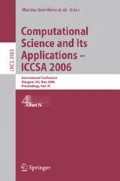Abstract
This paper presents a novel Chained-RIpple Time Synchronization (CRIT) protocol that is scalable, flexible, and high-precise in Wireless Sensor Networks (WSN). CRIT adopts hierarchical and multi-hop time synchronization architecture with contributing energy-saving effects in WSN. The algorithm works in two phases. In the first phase, a horizontal structure between Missionary Nodes (MN) is established in the network by Piggy-Back Neighbor Time Synchronization (PBNT) algorithm. In the second phase, a vertical structure between a MN and Sensor Nodes (SN) is set up in each sensor group (SG) by Distributed Depth First Search (DDFS) algorithm. By applying these two phases repeatedly, all nodes in WSN efficiently synchronize to each other. For the purpose of performance evaluation, we first study the error sources of CRIT. In addition, we simulate CRIT in terms of synchronization errors of two phases using network simulator.
Access this chapter
Tax calculation will be finalised at checkout
Purchases are for personal use only
Preview
Unable to display preview. Download preview PDF.
References
Lamport, L.: Time, clocks, and the ordering of events in a distributed system. Communications of the ACM 21(7), 558–565 (1978)
Cidon: Yet another distributed depth-first-search-algorithm. Inform. Process. Lett 26(6), 301–305 (1988)
Elson, J., Girod, L., Estrin, D.: Fine-Grained Network Time Synchronization using Reference Broadcasts. In: The proceedings of the fifth symposium on Operating System Design and Implementation, SDI 2002 (December 2002)
Chipcon CC1000 Radio Datasheet, http://www.chipcon.com/files/CC1000_Data_Sheet_2_1.pdf
The NS-2 simulator, http://www.isi.edu/nsnam/ns
Duda, Harrus, G., Haddad, Y., Bernard, G.: Estimating global time in distributed systems. In: Proc. of the 7th IEEE International Conference on Distributed Computing Systems (ICDCS 1987), Berlin, Germany (September 1987)
Mills, D.L.: Internet time synchronization: The Network Time Protocol. In: Yang, Z., Marsland, T.A. (eds.) Global States and Time in Distributed Systems. IEEE Computer Society Press, Los Alamitos (1944)
Awerbuch: A new distributed depth-first-search algorithm, Inform. Process. Lett. 20(3), 147–150 (1985)
Author information
Authors and Affiliations
Editor information
Editors and Affiliations
Rights and permissions
Copyright information
© 2006 Springer-Verlag Berlin Heidelberg
About this paper
Cite this paper
Shin, KY., Kim, J.W., Park, I., Mah, P.S. (2006). Wireless Sensor Networks: A Scalable Time Synchronization. In: Gavrilova, M.L., et al. Computational Science and Its Applications - ICCSA 2006. ICCSA 2006. Lecture Notes in Computer Science, vol 3983. Springer, Berlin, Heidelberg. https://doi.org/10.1007/11751632_56
Download citation
DOI: https://doi.org/10.1007/11751632_56
Publisher Name: Springer, Berlin, Heidelberg
Print ISBN: 978-3-540-34077-5
Online ISBN: 978-3-540-34078-2
eBook Packages: Computer ScienceComputer Science (R0)

